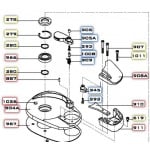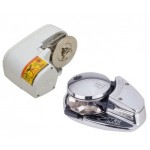Windlass Troubleshooting FAQ
This FAQ addresses common problems encountered with boat windlasses. Remember, when seeking specific advice, always include details about your boat, windlass model, and the specific issue you're experiencing. Safety is paramount when working with windlasses; disconnect power before performing maintenance unless specifically instructed otherwise.
My windlass is not working, what should I do? (Common problems and solutions)
1. Check the Power Supply:
- Circuit Breaker/Fuse: Ensure the circuit breaker for the windlass is on and the fuse (if applicable) is intact. Reset the breaker or replace the fuse if necessary.
- Battery Connections: Verify that the battery connections are clean, tight, and corrosion-free. A weak battery can also prevent the windlass from operating correctly. Test the battery's voltage.
- Wiring: Inspect the wiring to and from the windlass for any damage, loose connections, or corrosion.
2. Check the Windlass Itself:
- Manual Override: If your windlass has a manual override, ensure it's not engaged.
- Clutches/Gears: Check that any clutches or gears are properly engaged or disengaged, depending on the windlass type. Consult your manual.
- Motor: If the windlass is electric, listen for any sounds from the motor when you try to operate it. No sound could indicate a motor problem.
- Foot Switch/Remote: Test the foot switch or remote control to ensure it's functioning correctly. Try a different switch if possible.
3. Check the Rode (Chain and Rope):
- Snags/Obstructions: Ensure the rode isn't snagged or tangled. Clear any obstructions.
- Chain/Rope Condition: Inspect the chain and rope for damage or excessive wear. A damaged rode can cause the windlass to malfunction.
4. Consult the Manual:
If none of the above steps resolve the issue, consult your windlass's user manual for specific troubleshooting instructions.
Why is my windlass making noise? (Potential causes)
1. Normal Operating Sounds:
Some windlasses make noise during normal operation. Familiarize yourself with the typical sounds your windlass makes.
2. Lack of Lubrication:
Insufficient lubrication can cause grinding or squealing noises. Consult your manual for recommended lubricants and lubrication points.
3. Worn Gears/Bearings:
Worn gears or bearings can produce a grinding or knocking sound. These parts may need replacement.
4. Loose Components:
Check for any loose bolts, nuts, or other components that could be vibrating or rattling.
5. Rode Issues:
A damaged or improperly sized rode can cause unusual noises.
6. Motor Issues:
A failing motor can sometimes produce unusual noises.
How do I troubleshoot a windlass that is jamming or slipping? (Maintenance tips)
1. Jamming:
- Rode Inspection: Carefully inspect the rode for damage, kinks, or twists. These can cause jams.
- Chain/Rope Alignment: Ensure the chain and rope are properly aligned on the windlass gypsy (the wheel that grips the rode).
- Obstructions: Check for any foreign objects that may be lodged in the windlass.
- Lubrication: Lubricate the windlass and rode according to the manufacturer's recommendations.
2. Slipping:
- Gypsy Wear: Check the gypsy for wear. A worn gypsy may not grip the rode effectively.
- Clutch Adjustment: If your windlass has a clutch, check the adjustment. A slipping clutch can cause the rode to slip.
- Rode Condition: A worn or improperly sized rode can slip on the gypsy.
- Chain/Rope Compatibility: Ensure the chain and rope are compatible with the windlass gypsy.
3. General Maintenance Tips to Prevent Jamming and Slipping:
- Regular Cleaning: Clean the windlass and rode regularly to remove dirt, salt, and debris.
- Lubrication: Lubricate the windlass and rode according to the manufacturer's recommendations.
- Inspection: Inspect the windlass and rode regularly for signs of wear or damage.
- Proper Rode Sizing: Use the correct size and type of rode for your windlass and boat.
Important Note: If you're not comfortable performing any of these troubleshooting steps, consult a qualified marine technician. Improper maintenance or repair can cause further damage to your windlass and potentially create a safety hazard.




